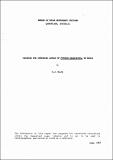| Author | Croft, BJ |
| Date Accessioned | 2012-11-13 |
| Date Available | 2012-11-13 |
| Issued | 1987 |
| Identifier | http://hdl.handle.net/11079/558 |
| Abstract | In the study of any soil borne pathogen it is essential to have some technique for determining the level of the pathogen in the soil. The levels of Pythium species in soil have been measured by soil dilution plating on selective media (Dick and Ali-Shtayeh 1986. Trans. Br. Mycol. Soc. 86(1):49-62). However species with lobulate sporangia are not frequently isolated on these media and bioassay techniques have been developed for these fungi (Stanghellini and Kronland 1985. Phytopathology 75:1242-1245). In Hawaii, pineapple roots have been used as baits in a bioassay for P. graminicola Subr. (Adair 1972. Hawaii. Plant. Rec. 58:213-240). However, considerable space is required to maintain pineapple plants and they are not always readily available. Poor Root Syndrome (PRS) of sugarcane in Queensland causes serious crop losses (Egan et al. 1984 ASSCT p 1-9). A Pachymetra sp. (formerly referred to as the root rot fungus) which rots the primary roots of the sugarcane plant, and P. graminicola which can restrict fine root development, are two pathogens consistently found in affected soils (Croft and Magarey, 1984 ASSCT Conf. p 55-61). The study of the role of P. graminicola in the sugarcane PRS in Queensland has been hampered by the lack of a means of quantifying the level of this species in soils. This paper outlines the development of a sorghum bioassay (SB) for P. graminicola using sorghum seedling roots. |
| Language | en |
| Publisher | BSES |
| Part of Series | BSES Internal Report; 1987 No 383 Report 309.01.050 |
| Subject | Soil |
| Subject | Pythium Graminicola |
| Subject | Poor Root Syndrome |
| Subject | Pachymetra |
| Subject | Bioassays |
| Subject | Sorghum |
| Subject | Techniques,Soil borne pathogen |
| Subject | Sorghum bioassay (SB) |
| Title | Bioassay for comparing levels of pythium graminicola in soils |

